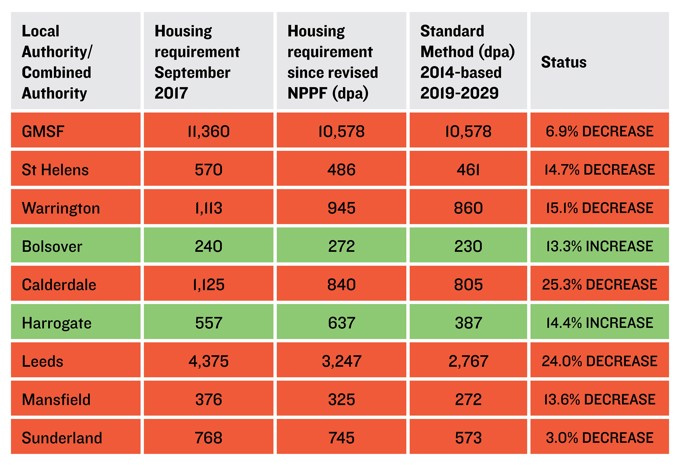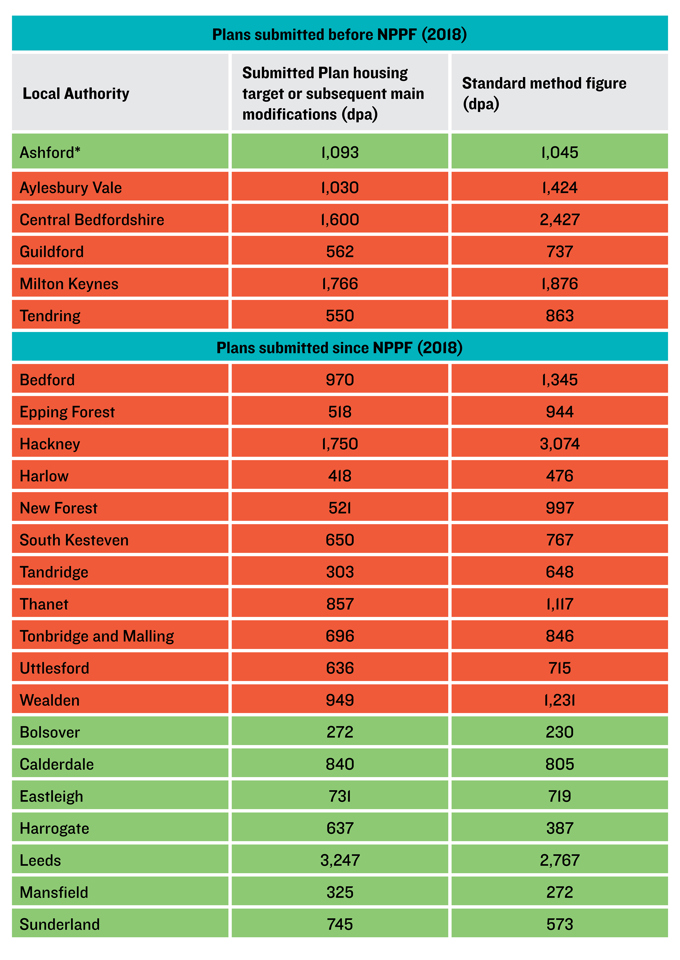Recent research by Lichfields examined how local authorities (outside London) with plans submitted or emerging under the new NPPF have responded to the introduction of the Standard Method for assessing local housing need. The research found that 50% of these plans were using the Standard Method figure for their local housing need figure. 34% were going above and 16% were going below. If these housing targets were realised, this would lead to a net increase of 1,450 dwellings every year, an uplift of 4% above the Standard Method figure, but far short of the 10% uplift needed to reach the Government’s target of 300,000 dpa.
We’ve now undertaken further research which illustrates the startlingly different impacts that the standard methodology is having in the North and South of the country. The three northern regions in our original research were planning for a 13% uplift above the Standard Method, compared to a proposed under-supply of 6% in the South East and East regions. Our new research reveals that the negative impact of the Standard Method on housing requirements has become even greater.
A New Comparison
Table 1 compares the housing requirement in a sample of northern local authorities’ plans as of September 2017, (when the Standard Method was first proposed), with the housing requirement identified in the latest version of their plans (published since July 2018). Across these local plans, the change represents a total decrease of c. 2,409 homes each year in comparison to the numbers these authorities aspired to deliver before the Standard Method was proposed. Of these authorities, two explicitly state that their revised housing figure is aligned with the Standard Method figure, whilst another five make reference to the Standard Method, either in the Plan or in supporting documents, but explain reasons for uplifting their number.
Table 1: Housing requirements in local plans immediately prior to the Standard Method being proposed in September 2017 compared to the latest draft Plan.

Source: Lichfields Analysis/Local Plans
The picture is actually likely to be far worse than is suggested in Table 1, which does not include local authorities that presented a range of housing requirement figures (i.e. those at Issues and Options stage either in September 2017 or currently). This includes Durham, who identified that their housing need would be between 1,533 and 1,717 dpa before the Standard Method was proposed but who have since lowered this to 1,308 dpa in the Submission Draft (June 2019), explicitly stating that their new housing figure is based on the Standard Method, plus an uplift to account for past delivery levels. Likewise, Richmondshire identified a housing requirement of 180 dpa in their Core Strategy adopted in 2014, which is above even the top end of the range of figures presented in their new emerging plan (15-160 dpa). Again, the Plan refers to the Standard Method as the basis for the low-end figure of this range. As such, the difference between the pre- and post-Standard Method housing requirements in the North is likely to be even greater than the 2,409 dpa shown in Table 1.
Historically, plans from northern local authorities have based their housing requirement on an economic-led future scenario, reflecting the need to ensure past trends of population decline are not perpetuated into the future and to help attract and retain skilled workers to boost local economies. When the Standard Method was originally announced, Lichfields alongside many other planning and housing professionals, raised concerns that the new approach would result in significantly lower housing requirements due to its reliance on affordability as the sole reason to apply an uplift. Whilst the option exists within the methodology to apply an uplift to align with economic aspirations, as this is only an option it means LPAs can choose to appease residents and councillors concerned about housing growth rather than support their economic growth strategies. This has the effect of constraining economic growth aspirations across the North. Based on the analysis above, it is clear that these concerns are being realised and it seems likely that this trend will continue and worsen.
What about the South?
Lichfields research (‘New approach for Local Housing Needs’, September 2017) showed the Standard Method would dramatically increase the housing requirements of southern authorities due to their past growth trends and affordability problems. But how have LPAs reacted to its adoption? Lichfields’ ‘Above Standard’ (July 2019) research identified that the majority of local authorities in the South and South East were planning to use the base Standard Method figure as their housing requirement or go slightly below it. At least 16 southern and south eastern local authorities submitted plans with housing requirements below the Standard Method figure either in the run up to the approach being adopted on 24th January 2019, or in the months after the Standard Method had first been proposed, thereby avoiding the higher figures calculated using the Standard Method (Table 2). Indeed, there was a spike in the number of strategic plans submitted to PINS in January 2019 just ahead of the deadline, with seven local authorities submitting their plans in this month alone, compared to the eight plans submitted in the previous three months combined.
Table 2: Comparison of housing requirements in latest local plans with the Standard Method figure.
 Source: Lichfields Analysis/Local Plans
Source: Lichfields Analysis/Local Plans
The table compares plans which were submitted after the Standard Method was first proposed but before this was incorporated into the NPPF (“Plans submitted before NPPF (2018”) and those submitted after publication of the NPPF but before the 24th January deadline (“Plans submitted since NPPF (2018)”). Plans with a housing requirement below the Standard Method are shown in red, those which exceed the Standard Method figure are shown in green.
*Ashford currently has a housing requirement figure which exceeds the Standard Method (13,118 dwellings between 2018 and 2030 or 1,093 dpa). However, this housing requirement has been adjusted from the OAN as a result of significant under delivery between 2011 and 2017 (2,462 dwellings shortfall).The OAN for Ashford (2011 to 2030) is identified as 16,872 dwellings, (888 dpa), which is lower than the Standard Method.
Table 2 clearly demonstrates that local authorities in the South East have submitted plans with housing targets below their Standard Method figures prior to the 24th January 2019 deadline, both before and after the revised NPPF was published. The housing requirements set out in these plans have typically been derived from Strategic Housing Market Assessments or Housing Need Assessments without reference to the Standard Method figure. Conversely, housing targets for local authorities in the North or Midlands have generally remained above the Standard Method figure (Table 2), albeit typically lower than previous local plan housing requirements. However, it remains to be seen how many more local authorities, particularly across the North, will reduce their housing requirements in light of the Standard Method’s figure prior to submission of their local plans.
Combined Impact
Figure 1 brings together the different responses local authorities in the North and South have had to the Standard Method. In the North, the Standard Method has generally resulted in housing requirements being lowered in order to align with the Standard Method figure. In the South, the Standard Method has not encouraged housing requirements to be raised and if anything, has seen local authorities accelerate plan progress to secure a lower requirement. The obvious interpretation is that in both circumstances local authorities have chosen tactically to use the lowest figure available, resulting in fewer homes than might otherwise have been planned for in the North or are about to be imposed in the South. As the Standard Method becomes mandatory, local authorities in the South will be caught by the Standard Method and will need to increase their local housing need accordingly. However, the housing “lost” in the authorities that rushed ahead with pre-Standard Method plans may never be recovered. Northern local authorities are likely to continue to reduce their requirements to align with the Standard Method without choosing ambitious uplifts to align with economic strategies.
Figure 1: The impact of the Standard Method in the north vs the south.

Source: Lichfields
Conclusion
The Standard Method was introduced in order to provide a simpler, quicker and more transparent approach that would speed up and simplify plan making and ensure delivery of sufficient homes throughout the Country. However, certainly in the short term, local authorities’ response to the Standard Method has resulted in local housing requirements being significantly reduced, rather than increased, undermining the Government’s aim to boost housing delivery to 300,000 dpa. This illustrates the propensity for local political motives to use the planning system contrary to national objectives. A change to the Standard Methodology to require the alignment of housing requirements with economic growth strategies would help to address this problem.






